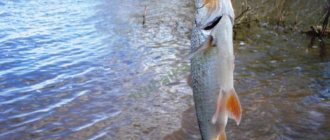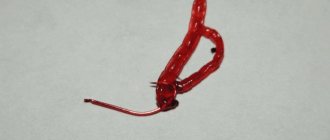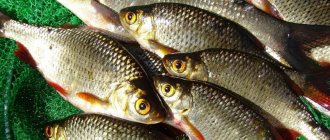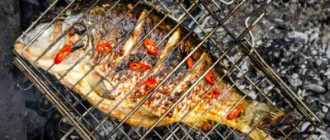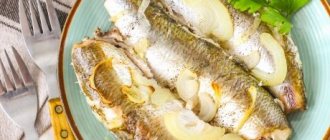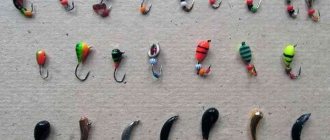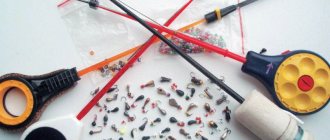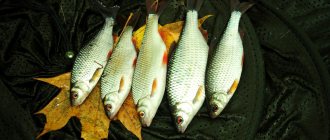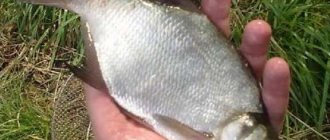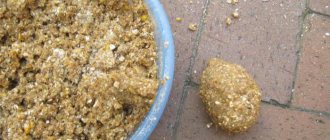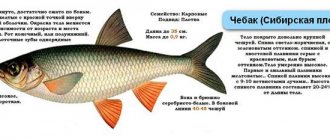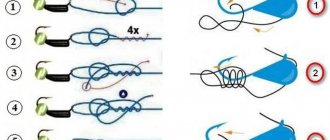The article talks about catching roach on lakes from the shore using a fishing rod. Important issues related to finding the best places, feeding complementary foods, equipment layout, and selecting suitable gear are covered.
The basis of my entire float strategy is fishing on lakes with depths of 2.5 m, which are adjacent to the shores. Let me slightly alter the well-known proverb: “ The fish looks for where it is deeper because it is better there .” So I strive for depths both in the summer heat and in the autumn cool. Even in the spring, when fish more often than ever come out to shallow places to warm up and eat, I often find good fish in the depths, this even applies to the cunning crucian carp, which is bolder in such areas.
Roach fishing spots
Fishing the most productive lake depths of 2.5-3 m from the shore is no problem at all. I usually fish in conditions where there is a meter of depth five meters from the shore, and at 10 m it’s already 2.5 m, at 12 it’s still 3 m. Then there’s usually a plateau or a gentle slope, I also reach it with a long cast, but usually good results come from there didn't receive it.
When fishing from the lake shore, I first of all hunt for large roach. By the way, I often hear that already in the last ten days of May the bite of this fish noticeably declines. Has the spring zhor reached its finale? Maybe, but in the first half of June the roach bites very well, although the bite will mix into deeper areas. In July it gets worse, and in cooler August the roach bite noticeably picks up again.
Classic roach sites are usually located next to a sandy steep bank, where there is no dense vegetation at the bottom. Bream also often lives there; I don’t purposefully hunt for it with a fishing rod, but if I catch it, then, of course, I will be happy with such a catch. By the way, often a respectable bream is suitable for roach bait, then it is more profitable to catch it with bloodworms, which the bream adores. But the lake roach is not very fond of this bait. Sometimes it works better on a regular bread crust, which I cut into small squares measuring 4 by 4 mm. In water, such a bait swells considerably and attracts roaches with disintegrating small particles.
What kind of fish lives here?
In “Russian Fishing” on the “Lake” there is a wide variety of fish, except perhaps the most exotic.
“Under the canopy of the maple” the most common fish caught are rudd, char, carp, roach and silver carp. Accordingly, it is best to fish here with baits such as bloodworms, worms, bark beetle larvae, bread and dough.
Quiet Western Backwater is worth a visit if you want to catch goldfish, crayfish, bleak or pike. Crucian carp takes well for bread and dough. The best bait for crayfish is a worm and pieces of meat. Bleak catches flies and bread very well. But for pike it is better to use an oscillating spoon or frog.
“Vetreny Plyos” is a very rich place. Ruff, silver and golden crucian carp, carp, tench, perch and pike are found here in abundance. A win-win option would be a worm, bloodworm, bread, dough and crayfish when catching herbivorous fish, as well as small spoons, whitebait or a frog for predators.
In the “Berezovaya Flooded Coast”, it is worth stocking up on maggots, worms, peas, bloodworms, pearl barley and pieces of meat, because quite a variety of fish live here - although not a lot of predatory ones. But there are loaches, gudgeons, roaches and bream, as well as crayfish.
On the “North Coast” the bait is good for char, carp, rudd, roach, pike perch and silver carp. A wobbler and twister are best suited for pike perch. Silver carp loves cabbage. It is good to catch carp using corn. But for the rest, bloodworms, worms, bread, dough are suitable.
On the “Forest Beach” there is freedom for dace, gold and silver crucian carp, perch and carp. Stock up on caddis flies, dough and bread, a twister and a boilie with makukha, so that you can return from fishing with decent trophies.
Finally, if you fish in the “Southern Bay”, you will find goby, dace, gudgeon, bleak, ide and a lot of rotan. In your arsenal you must have a fly, a worm, a bloodworm, a caddisfly, and bread. For ide, grasshopper, corn and a small circulating spoon are suitable.
Now you know where to fish on the “Lake” in “Russian Fishing” and you will probably quickly catch a bunch of decent trophies.
Roach rig
I adjust the equipment on the “roach” fishing rod so that the hook (No. 5 according to the old numbering) is close to the bottom soil, but at the same time does not lie on it, in this case, when there are gusts of wind, the equipment will begin to drag a little along the bottom - The lake roach loves this movement of the bait! In strong side winds, after some time, you need to re-throw the gear, but a much larger area is fished. And then very promising places are found. It’s hard to say what’s there on the bottom soil, perhaps it’s some kind of interesting mound, but in some randomly found places, there are much more roach bites, even if they are located well away from the feeding point. When the wind gets really strong, I try to position myself so that it blows at my back - broken lake shores usually allow me to find such convenient places. In this case, there are no questions with the quick removal of the equipment - I hold the line, or let it go a little, then pull it towards me. Solid bleak also loves fresh wind; it responds best to a couple of maggots on the same hook No. 5.
Bait for roach
There’s nothing complicated about the bait; I use ordinary breadcrumbs, just mix them with sand. When I catch roach using pearl barley, I try to add it to the bait, and without regret, I steam a full glass of cereal for half a kilo of crackers. Throwing lumps of bait accurately at 15-16 m by hand is not a problem. I try not to moisten the bait too much; in any case, there is no need to make the mixture particularly liquid; the bait ball must pass through the water column and disintegrate at the very bottom. When casting bait, its particles often fall off the ball, splashing down not far from the shore, thereby feeding points close to the shore, which are also worth catching during fishing - it happens that I catch a lot of fish right here.
Roach in Russian lakes. Fishing and methods of catching roach
The roach is a fish that is found everywhere, but loves calm, warm water with abundant aquatic vegetation. The weight of this fish reaches up to 2 kilograms, although a roach weighing even 300 grams is already considered large.
The largest roach is found in reservoirs and lakes. It spawns in rivers during the period when birch and alder leaves bloom, and in lakes and reservoirs - during the time when bird cherry begins to bloom. Roach is a schooling fish. In particular, huge flocks gather during spawning periods. Large fish spawn mainly in the same places where they live, most often in reservoirs and lakes. Medium-sized fish go into rivers during spawning, rising as high as possible against the current, sometimes even 25 kilometers.
At the end of the winter period, most often 8 days before the opening of the reservoir from the ice crust, the roach leaves the winter quarters. Then they go to the very shores, and after that to the floodplain, flooded with water, and enter bays, oxbow lakes and lakes, where they remain until spawning. After the end of spawning, the roach tries to avoid strong currents. Large roaches rarely leave reservoirs and lakes. During spawning, it approaches the shore of the bay with hard, submerged algae and coastal bushes.
The most successful roach catch begins after the sound of drops on village roofs. Having gathered in schools, the roach reaches the mouths of the flowing channels. In most cases, it enters the oxbow channels. It approaches the shore and is caught in a place where there is at least 20 centimeters of water between the ice and the bottom. At this time, it is best to catch roach using fishing rods with a float through small holes. In the process of cutting these holes with the help of an ice pick, the fish begin to leave the shallows. It is necessary to maintain complete silence and be careful, avoiding sudden movements on slippery ice. The roach feels every sound, and even the slightest pressure on the ice. All this may frighten her. The best baits at this time are bark beetles, shitik, bloodworms, and in some cases grandma or a worm.
Every day the roach bite begins to increase. Fishing should continue until the ice can support the weight of the fishermen. It should be noted here that it is mainly on the last ice that it is possible to catch the largest specimens of roach. At the end of the season, when gullies appear along the current, you can start catching roach with summer gear - using a wireline. Many fishermen prefer this type of fishing, although it requires great care and discretion. Under no circumstances should you approach areas with thin, dark ice.
When you finish fishing from the loose ice of reservoirs and lakes, you can start it on the open water of small rivers, where it begins to warm up and clear before anyone else. Roaches go to such rivers to spawn. Initially, fish can be caught near the mouths, and as it warms up, you can move upstream, but more than 20 kilometers from the mouth. During spring fishing, bait can stop moving roach for a short time. But at the same time, it is best to find quiet places in a bay, river or channel with a weak current, where the roach rests.
As the roach enters the rivers, the bite increases significantly to a zest. The most successful is fishing in a pond with bloodworms, but after 6 days, fishing with a rod and float with a bark beetle, worm or granny often becomes successful. After spawning is completed, the roach begins to split into small schools, scattering throughout the reservoir. Individuals that went into the rivers to spawn return to their original place.
Roaches feed around the clock all year round, but night feeding reaches a particular intensity only during the hottest period. Based on this, in summer it is best to catch roach at night. Cloudy but warm weather always revives the bite. And once again it should be noted that bait is always useful for successful roach fishing, but in the summer it is simply necessary. And you should not keep the caught roach in the cage.
Loading equipment onto roach
The lighter the better, which allows you to successfully combat frequent thieving bites. Accordingly, I set the floats to be light enough for long casts - 1.5-4 g. The load consists of three or four weights of the same weight. The first one is installed at the leash attachment loop (it has a length of 15-20 cm), the rest are located higher along the fishing line at a distance of 5 cm from each other. Weights weighing 0.5-0.9 g, I try not to install more massive ones. Such equipment at the same time allows you to control bottom fishing, not alarm the fish, avoiding overlaps. In strong winds or when longer casts are necessary, loaded floats with a total lifting capacity of 6-7 g have performed well. The main load is built into the lower part of the float itself. It is finally loaded with lead weighing 1-1.5 g on the fishing line.
An important question - fishing line
A thin main one (0.14-0.18 mm) increases casting range, works better with sliding floats, but forces you to use thin leashes, which is unacceptable for me. After all, even when fishing for roach, other large fish regularly tumble in that you would like to get. Very often, nimble kilogram carp like to test the strength of thin float equipment. Large crucian carp also sometimes presses a chatterbox or pearl barley so that you won’t envy a thin leash. Once I pulled out two very respectable perches using bloodworms. Of course, it would be foolish to try to create a universal equipment that is well suited for fine roach fishing and confidently playing heavy carp. But it was possible to find a certain golden mean when the tackle is not too rough and at the same time retains sufficient strength, which is needed both when fishing and in withstanding the dangerous “sharp” shell bottom. I have a main vein of 0.23-0.25 mm, leads from 0.12 to 0.20 mm, I set the specific diameter depending on what kind of fish is taking, how active it is, whether there is snags or dense grass nearby. In the latter case, forced fishing is always required, so a 0.20 mm leash is just what you need.
Where to fish here
Let's start with the fact that the “Lake” location itself consists of 9 places where you can successfully fish. Of course, on each of them there are certain species - some are everywhere, but the number, most often, is very different.
First of all, the game will direct you to the place “Under the Shadow of the Bite”. Here the training will take place and the first trophy roach will be caught. And overall the place is quite good and catchable.
Also, it is on the “Lake” that such places as “Quiet Western Backwater”, “Windy Reach”, “Berezovaya Flooded Shore”, “North Shore”, “Forest Beach” and “Southern Bay” are located. It's nice that all the scenes are worked out amazingly accurately. The musical accompaniment is well chosen, which allows you to perfectly relax after a hard day at work, enjoy peace, silence and a light bite, which is signaled by the float.
Each of the listed sublocations can provide a rich catch. But here it is very important to know what kind of fish lives where, as well as its biting time (one bites all day, and the other at night, in the evening or in the morning) and suitable bait. Let's talk about this briefly now.
